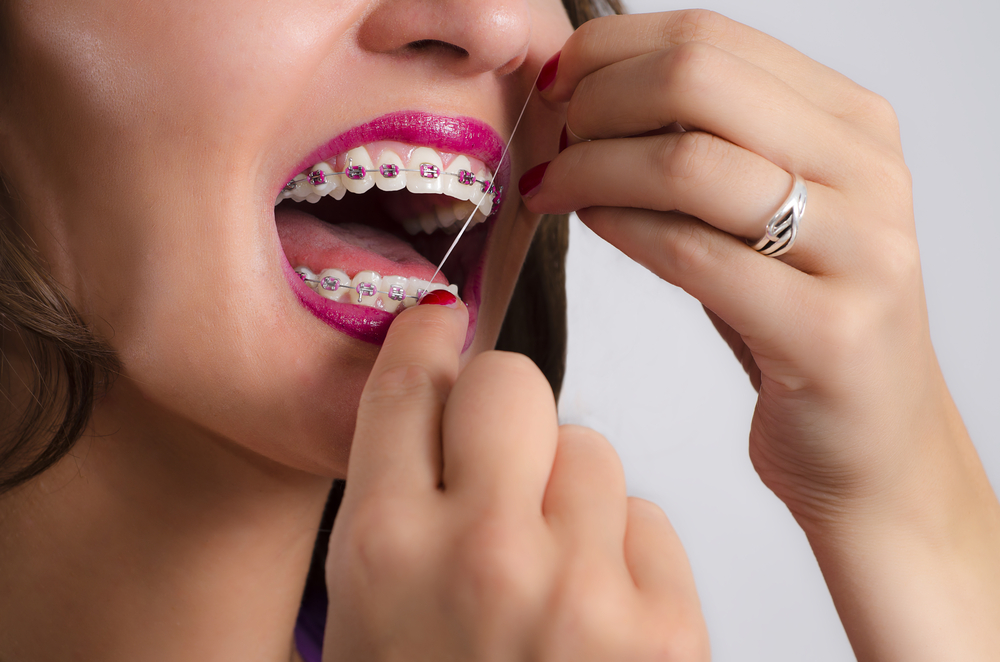Dental Emergencies With Braces

Braces are incredible devices that can help transform your teeth and reshape your jaws. However, they are not always fool-proof. Every so often, a patient will have a dental emergency. That may be a bad cavity that needs to be fixed, or a bracket or wire will break. There are only a few dental emergencies that can happen with braces. We can help you to know what to do when each of those emergencies happen!
Origins of Braces
Orthodontic treatments have been around for a long time-even as far back as the ancient Egyptians! Although their ways were archaic, people for centuries have been trying to fix crooked teeth and develop a prettier smile through orthodontic work. The ancient Greeks, Romans, and Etruscans were known to have practiced orthodontia, and interestingly, the Etruscans used to attach gold bands to women’s teeth to preserve the position of their teeth after death. Orthodontics saw a surge in progress during the 18th century thanks to Pierre Fauchard. Known as the “Father of Dentistry,” he invented an appliance called a bandeau, which was a horseshoe-shaped piece of metal with regularly spaced holes that fit around the teeth to correct the alignment. He would also use forceps to physically realign teeth into their correct positions and tie them to neighboring teeth until they healed.
Orthodontics in the United States exploded during the 19th century. J.S. Gunnell created a type of headgear that fashioned to the head and exerted a soft pull on teeth while Charles Goodyear invented vulcanized rubber which would eventually become one of the most commonly used appliances in orthodontics. But Edward Hartley Angle, the “Father of Modern Orthodontics,” took orthodontics to another level by identifying the true properties of malocclusion, or misalignment, and addressed them with his own set of orthodontic appliances in 1880. Until the 1970s, orthodontist would attach anchored brackets around each tooth with winding wires, but with the invention of dental adhesives, orthodontists could then stick the brackets to teeth surfaces. Stainless steel then replaced gold and silver as the most popular option for wires, due to its manipulability, and became the most cost-efficient option for braces.
Dental Emergencies and What To Do About Them
Braces have come a long way since their beginnings many centuries ago, but as braces have evolved, so have the problems that come with them. Although dental emergencies are few and far between when it comes to braces, there are some common issues that can be readily addressed and fixed if serious enough. The least serious issues that you can have with your braces is tooth tenderness and lip and cheek sores. As your teeth become accustomed to your braces, your teeth will most likely be sore for 2-4 days. Using headgear, rubber bands, and springs can add to this soreness, but that discomfort normally goes away in the same amount of time. Eating soft foods and taking an over the counter pain reliever can help dull the ache. Loose or broke bands and brackets are also another annoyance that sometimes occur with braces. Although not considered an emergency, they normally break due to patient’s eating prohibited foods or picking at their braces. Whenever this occurs, place a piece of wax on the spot of irritation and wait until your next orthodontic appointment, unless the broken bracket breaks on one of the upper or lower front four teeth, then call your orthodontist as soon as possible.
Protruding wires are not only bothersome, but can stab the inside of your lips and mouth if not fixed. Wires can come loose from eating sticky foods, like candy, or by picking at your braces. If this has occurred, try using a Q-tip or pencil eraser to push the wire in towards the teeth. To avoid accidental damage to the wire, make sure to not bite your nails or pens and pencils. In rare occasions, a piece of the appliance may break and be swallowed by the patient. Although alarming, keep calm and have someone look in your mouth to see if the appliance if visible. If confident that you can remove it, you may carefully attempt to do so. If you are unable to see the piece, are coughing excessively, or having difficulty breathing, that could be a sign that the piece could have been aspirated and you should contact your orthodontist immediately.
How To Protect Your Braces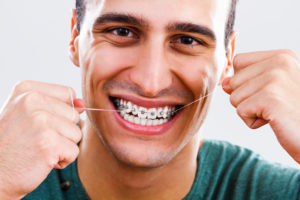
Unless under extenuating circumstances, most dental emergencies are avoidable. Maintaining good oral health and hygiene throughout your time with braces is vital in ensuring healthy teeth and gums, and preventing cavities. Food particles are easier to get stuck between braces, and when not cleaned thoroughly, can lead to other dental emergencies, like tooth decay, which can cause major complications. Hard foods, sticky foods, and foods high in sugar should be avoided as they are known to break brackets and cause cavities, which you more susceptible of developing while wearing braces. Some of the need-to-avoid foods include hard candy, nuts, apples, popcorn, ice, gum, caramel, and licorice.
Because braces are so notorious for getting food stuck in them, make sure that you are brushing after every meal to prevent staining and reducing bacteria buildup in your mouth. Use a soft brush, and brush each tooth by starting at the top and brushing down, then repeating the motion and brushing up around each bracket. Use threadable floss of a floss threader to get the hard to reach areas in between teeth that are covered by the archwire. Using the pointed end, insert between the teeth and gently move the floss back and forth between the two teeth. For added care, use a proxabrush, sometimes called a “Christmas tree brush,” to scrub between each bracket in an up and down motion to get any extra gunk that might be stuck there. For any dental emergencies that you might be having, make sure to contact Belmar Orthodontics at (303) 225-9016 for your next consultation!
Braces With Oral Health Problems
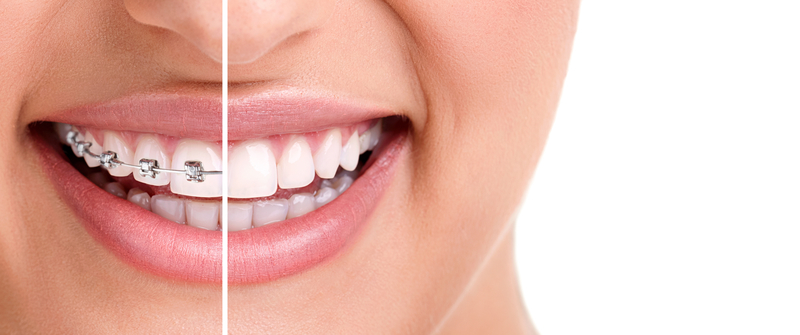
Did you know that your oral health can affect your overall health? Poor oral health can even worsen health conditions you already have such as diabetes or cardiovascular disease. That is because oral health and overall health are highly connected. Your oral issues can become better with braces, but that is only if certain oral health problems are corrected beforehand. Patients can also develop oral health problems if they don’t have the right knowledge with proper braces care. Use these tips to avoid oral health problems with braces and find out how we work around current problems to provide you with a straighter smile!
Oral Health Goals
Did you know that orthodontic treatment can give you a healthier mouth? We know that braces help straighten your teeth, but they can also improve the health of your gums and teeth. When you have crooked and crowded teeth, this makes cleaning your mouth more difficult. This can cause serious oral health problems, such as tooth decay, periodontal disease, and tooth loss. Whether you have straight or crooked teeth, before you let an orthodontist start working on you, there are some important oral health tips to be following before any work begins:
- Eat a healthy diet that limits sugary beverages and snacks
- See a dentist regularly for prevention and treatment of oral disease
- Brush teeth twice a day with fluoride toothpaste
- Floss daily
- Discuss changing certain lifestyle practices, like smoking and using oral piercings
Types of Braces
Braces are a big commitment, and you want to make sure you’re using the correct ones whenever you get them put on. Each of us is a different size and shape, and are mouths aren’t any different. Because of this, there are various types of braces for different sizes and shapes of mouths for children, teenagers, and adults. The four most common types of braces are: traditional, short-term, clear, and Invisalign/ClearCorrect.
Traditional braces are those that we see on a daily basis: a system of wires and brackets that are bonded to our teeth. This type of braces are the most cost-effective, reliable, and are best suited for severe orthodontic issues. Short-term braces are recommended for those patients who wish to align just their front six teeth-the ones that others see the most. These are used for the shortest amount of time (less teeth to align), but there is no adjustment to your occlusion (bite). So if you have a problem with an under/overbite, short-term braces may not be for you. Clear braces are similar to traditional metal brackets except that they use ceramic brackets that match the color of your teeth. These braces have a high aesthetic appeal for those who don’t want to be seen wearing braces, plus they are highly resistant to staining. Invisalign//ClearCorrect straighten your teeth without the traditional wire brackets, and are completely removable, which makes cleaning your teeth a cinch. This type requires more responsibility for the wearer, but if you’re committed to the strict wearing regimen, you can have a straight smile in as little as 12 months!
Taking Care of Your Braces
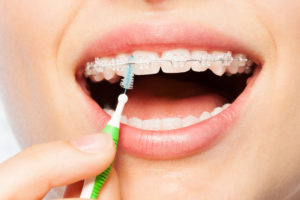
While similar to managing our oral health, maintaining our braces has a few extra steps. To maintain good oral health with braces, it’s important to adopt good oral hygiene throughout the entire process. Brushing after every meal is one of the most important but most overlooked steps in maintaining good oral health. When eating, food particles get stuck in between our teeth and our braces, which can cause staining and bacterial backup between our teeth. Using a regular soft brush in an up-and-down motion on each tooth will do the trick. Secondly, use threadable floss or a floss threader. These tools allow you to get between each tooth and underneath the wires to clean out any food that may be trapped there. Insert the threader between two teeth and move back and forth until the food is released. Lastly, use a proxabrush, or a “Christmas tree brush.” Place the proxabrush between two brackets, below the archwire, and brush up and down. Like the threader, this will also help loosen up any food that may be stuck between your teeth.
A great way to ensure that your braces don’t break and that you don’t get unwanted gunk stuck in them is to watch what foods you’re eating. Foods that are hard, sticky, or high in sugar should be avoided. Eating food that is high in sugar can cause cavities when wearing braces, which can lead to more dental work that you would need to have done. Furthermore, patients with braces should limit between meal snacks and avoid food that could bend the wires, such as caramel, nuts, chewing gum, ice, or popcorn.
When To See An Orthodontist
Now that we understand more about the importance of our oral health, plus the different types of braces, when should we make an appointment with an orthodontist? Many times, we only schedule a time to see an orthodontist whenever our teeth are crooked and we want them straightened. But there are other factors that influence when we should start thinking about getting in to see the doctor:
- Jaws that shift, make sounds, protrude, or are recessed
- Speech difficulty
- Biting the cheek or biting into the roof of the mouth
- Facial imbalance or asymmetry (features out of proportion to the rest of the face)
- Inability to comfortably close lips
- Grinding or clenching of teeth
As mentioned earlier, these are signs that your oral health might not be up to par like it should be. Meeting with your orthodontist and discussing these issues will help them better treat you with one of the four types of braces that we discussed previously. The sooner you get in to see your orthodontist, the sooner any pain or discomfort can be evaluated, treated, and extinguished.
Meet Your New Year’s Resolutions With Our Help!
Belmar Orthodontics can help you on your path towards having a straighter smiles and better oral health. With reputable orthodontists, manageable treatment plans, and services for children and adults, we can help you get the smile that you deserve! Call (303) 225-9016!
Cavity Treatment During Braces
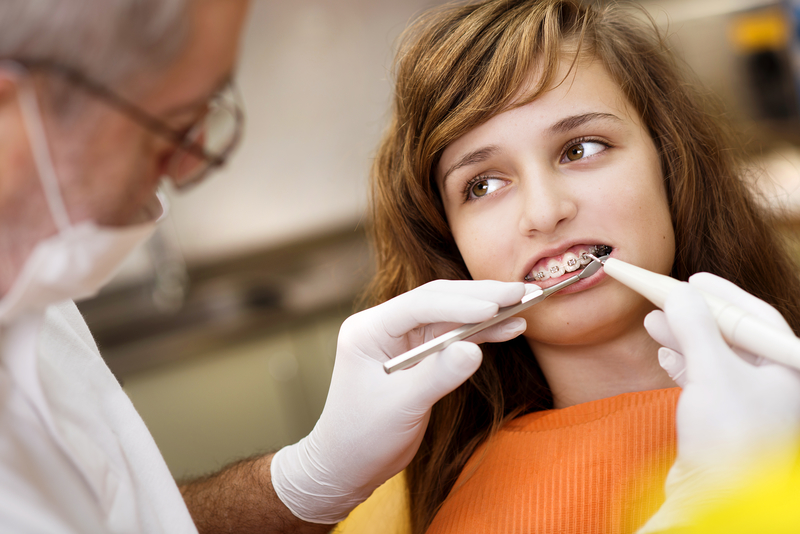
Did you know that an orthodontist and a dentist are not the same? Only a dentist can help with cavities, gum disease and more, while only an orthodontist can straighten your teeth in a certain way. A patient’s time with braces is a time when cavities happen very quickly, because the teeth are harder to clean. To prevent cavities during your time with braces, it is vital that you continue to see a dentist. If you do happen to get a cavity, find out what that cavity treatment will look like!
Proper Oral Hygiene
The American Dental Association recommends that every patient brush their teeth at least twice a day to avoid tooth decay. Brushing after every meal is even better for avoiding plaque buildup that leads to decay. Every patient should also floss their teeth at least once a day. Using fluoride toothpaste is best, because fluoride helps coat the teeth in a protective layer that prevents decay and keeps tooth enamel stronger. Patients can also benefit from mouthwash, as it can kill bacteria that would otherwise create plaque.
However, these recommendations are for people that don’t have braces. Every single person—children, teens and adults—should follow these recommendations. Infants should not use fluoride or mouthwash, but their child toothpastes generally have safe amounts of fluoride in them. If you are a patient that is receiving orthodontic care via braces, you have to go the extra mile with your oral hygiene. That means more frequent brushing, more flossing and watching what you eat.
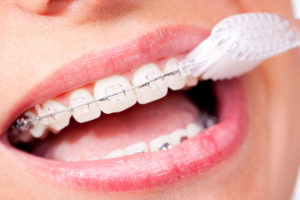
Taking Care of Braces
Braces can be tricky to clean. However, their design provides the best and quickest way for you to straighten your teeth, which is why traditional metal braces have been around for so many decades. Metal braces, ceramic braces and lingual braces all have a brackets-and-wires design.
However, with braces, you must be meticulous with cleaning them or you will have food and plaque get stuck places. If you don’t unstick those substances, they will quickly erode your tooth enamel and cause decay around your appliances. This can happen on every tooth as well.
Follow these tips for cleaning your braces:
- Brush after every single meal. This reduces staining and bacteria buildup. Use a regular soft-bristled brush and brush down from the top, then up from the bottom. Brush in all different directions to dislodge food.
- Use a threadable floss or a floss threader. Both will require that you thread the floss through each space between your teeth. You will have to go under the wire to do this, and it will take slightly longer than normal flossing. This is one of the most important oral hygiene recommendations to follow!
- Use helpful tools. A proxabrush is a small braces brush that can help unstick foods. It looks like a tiny Christmas Tree brush. A waterpik is also helpful. This is a tool that helps blast away food particles with a stream of water.
Tooth Decay with Braces
Many children and teens skip flossing or brushing here and there. Every time you skip on an oral hygiene habit, it increases your risk for tooth decay—or cavities—with braces. Your time with braces is one where you have to be super careful about your oral health. Most people picture their beautiful smile after getting their braces off, but they don’t think about cavities and tooth erosion. You can end up with tooth decay and parts of your teeth that have eroded due to your oral hygiene habits with braces.
Nobody wants to spend 18-24 months perfecting their teeth only to be disappointed in their smile. That’s why oral hygiene is so important. Tooth decay happens rapidly, and it can happen where the brackets are bonded to your teeth and in-between your teeth because it is harder to floss. Normally, you would simply visit the dentist and have your cavity removed and filled. However, cavity treatment is a bit different with braces.
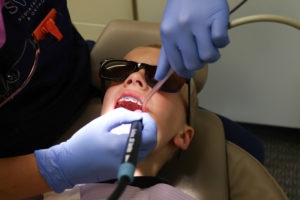
Cavity Treatment with Braces
Cavity treatment is slightly harder if you have braces, but not impossible. Generally, decay happens between teeth cracks and around brackets and wires. If you have tooth decay that is in a tricky spot, we can remove your wire so that a dentist can provide you with a proper cavity treatment. You will have to have your appointments scheduled close together (dentist and orthodontist) so that you can get your cavity filled and your wire replaced.
In severe cases of tooth decay, we may have to remove a bracket from the tooth if it interferes with the dental work that needs to be done. We only do this in certain cases, and we replace the missing part as soon as possible so your teeth don’t move. Cavity treatment—with taking out the tooth decay and filling it—is the same with braces as it is without, only you have to work around orthodontic appliances if you have braces. Always let us know if you have tooth sensitivity, sharp (and even mild) pain when chewing and if you have sensitivity to hot or cold foods. This signals that there may be a more severe cavity.
Prevent Cavity Treatment
The goal of every patient—old and young—is to avoid tooth decay altogether. If you do, you’ll never have to worry about cavity treatment with braces. If your decay is small and in a tricky spot, you may have to wait until your braces are off to receive your cavity treatment. That might make your cavity grow larger, which is something you don’t want. Always see the dentist to check your mouth for tooth decay before you receive orthodontic treatment. This can avoid many problems in the future.
If you are prone to getting cavities or you have weak enamel, consider receiving Invisalign treatment instead of getting brackets and wires. This will help you avoid problems with cavities and needing to get cavity treatment. If you have tooth pain or want to learn more about cavity treatment with braces, call Belmar Orthodontics today at (303) 225-9016!
Are Your Teeth Cleaning Habits Good Enough?
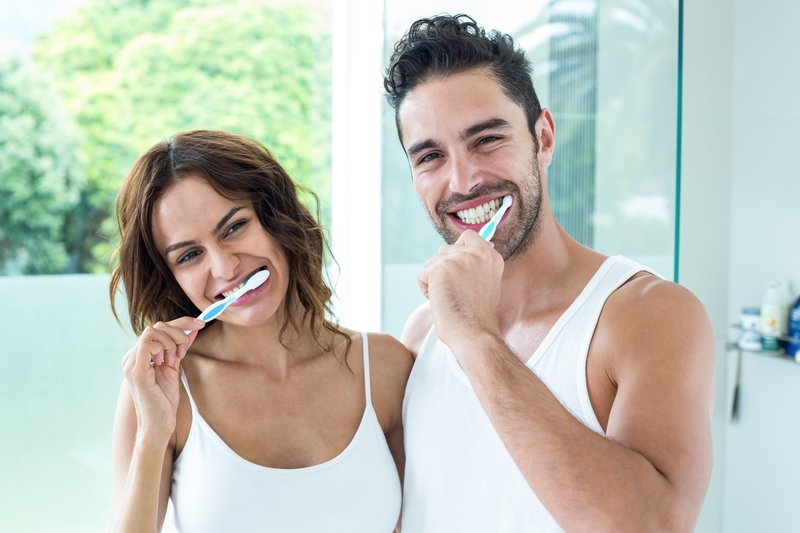
Braces can keep your teeth straighter, making them more beautiful and attractive. However, if your teeth cleaning habits are poor, your smile will take a hit. How well you take care of your teeth before and during braces will be an indication of how your smile will be after your orthodontic care has come to an end. If you don’t brush and floss the teeth enough, you might damage your smile and weaken your enamel. You must step up your cleaning routine during braces to make sure your smile isn’t full of cavities and oral health problems at the end of your care. We can give you the proper recommendations and guidelines to ensure you keep your smile healthy and strong during your time with braces and throughout life.
Brushing With and Without Braces
The American Dental Association recommends brushing and flossing the teeth at least twice a day to keep your mouth healthy and to lower your risk for tooth decay and gum disease. We go beyond that twice-a-day recommendation and suggest that you brush your teeth after every meal. Because your braces can easily attract and trap food particles, brushing after each meal can help prevent staining and reduce the potential for bacteria buildup.
You should use a soft-bristled brush and use one that’s size fits your mouth well. For teeth without braces, the ADA recommends brushing the teeth at a 45 degree angle. Brush each individual tooth, making sure to go all the way up to the gumline. You use a soft-bristled brush to avoid irritating the gums and eroding your tooth enamel. With braces, you want to brush down from the top, then up from the bottom on each tooth with a bracket. This will help dislodge food particles that have become trapped inside the brackets, which is extremely easy to do. Brushing your teeth multiple times a day is one of the best cleaning habits for avoiding decay.
Flossing the Teeth
We recommend flossing your teeth at least once a day. However, that’s for patients that don’t have braces. When you have braces, it’s even more important to floss each and every tooth. It’s also much more time consuming, but the effort you put into your teeth cleaning habits will pay off in the long run. A toothbrush and mouthwash simply can’t get in between the teeth like floss can, so if you skip flossing, you could have food sit and decay your teeth.
You will have to use threadable floss or a floss threader to accomplish this feat with brackets. If you use a floss threader for your teeth, think of your cleaning habits like you’re sewing. You floss the eye of the threader through your teeth and below the archwire. Then you floss the space, pull it out and thread once more. Make sure you don’t apply force or pressure against the archwire as you do this. For some patients, it may take about 10 minutes to floss, but it’s worth taking the time to avoid tooth decay.
Caring for Braces
Caring for your teeth becomes trickier with braces. You will find that you have to devote some extra time to caring for your braces, as you know have about 32 teeth that all have brackets that can collect food. During your time with braces, it is particularly important to maintain good oral health through attention to proper oral hygiene and cleaning habits. If you don’t, you could have your braces removed only to find that many of your teeth have areas of tooth decay. You could also be left with demineralization that leaves marks on all your teeth where the brackets were.
When it comes to caring for your braces, it’s not only important to clear away food particles that are on the teeth, but to be careful of what foods you put into your mouth. To avoid damage to your braces and your teeth during orthodontic treatment, you want to avoid hard foods, sticky foods, and foods high in sugar. This means you should avoid eating foods such as hard candy, chips, ice, apples, nuts, popcorn, carrots, corn on the cob, gum, caramel, taffy, licorice, gummies, and similar foods. Prevention is always key for avoid oral health issues!
Proper Teeth Cleaning Habits
If you’re going to spend 18-24 months straightening your teeth, you might as well keep those teeth healthy so they look nice at the end of your treatment. Brush your teeth every single day, multiple times a day. Floss as well and be meticulous with your cleaning habits. The better care you take of your braces while they’re on, the more you’ll enjoy your smile when they come off. If you would like help with your cleaning habits or tips, call our Belmar Orthodontics office today at (303) 225-9016!
Why Having Good Oral Hygiene Is Important
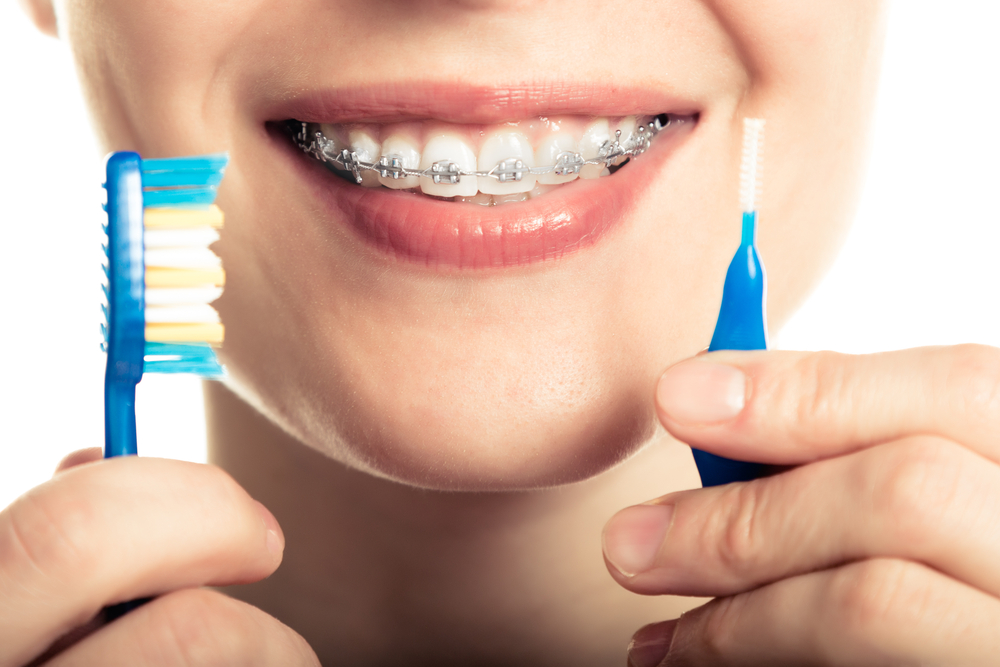
Millions of Americans don’t practice good oral hygiene, which is the #1 reason teeth decay and fall out. Good oral hygiene coupled with good nutrition can help prevent gum disease, tooth decay and even bad breath. It will also help us to be able to straighten your teeth without damage and provide you with a more brilliant, beautiful smile. There are many tips for keeping your teeth healthy and strong. Many of these tips have to do with nutrition and overall good oral hygiene. Good nutrition can aid in better health for you and for your teeth. We want all of our patients to be able to achieve a healthy mouth, but the first steps begin before you even come to our office. At Belmar Orthodontics, learn more about good oral hygiene and how orthodontic care can help you!
Practice Good Oral Hygiene
Sometimes, the basics are the hardest to do because they seem so simple. You skip brushing one night, then you do it again, and soon it starts to become a habit. When it comes to braces, we see patients skip on the basics here and there all the time. Why? This is most likely because braces take a little bit longer to care for than teeth without braces. Skipping on proper brushing and flossing can seriously damage and erode the tooth enamel.
The Prevalence of Decay
We recommend brushing and flossing at least twice a day, if not more. After every meal would be ideal, but not everyone makes a habit of doing that. What happens when you don’t brush and floss the teeth properly? You develop dental caries. The American Dental Association reports that 91% of adults 20 years old and older have had dental caries. 27% had untreated tooth decay. What does this mean? It means that 91% of people have had cavities and 27% had untreated cavities that will continue decaying. The National Institute of Dental and Craniofacial Research reports that dental caries is the most prevalent chronic disease in the United States in both children and adults. The sad part? It’s completely preventable.
Tooth decay occurs when proper oral hygiene practices are not followed. When we eat and drink, bacteria in the mouth mixes with sugar to make acidic plaque. That plaque coats your teeth and over time, erodes the hard tooth enamel. Inside the tooth is a soft, pulpy center that contains nerves and sensitive parts of the tooth. When hygiene practices are skipped, that plaque will erode the teeth enough to break down the enamel and seep into the soft, pulpy center. It will then have a heyday and cause as much decay as it possibly can. Mild tooth decay will result in fillings for cavities. Severe tooth decay will result in a root canal or a dental extraction. The great part about all of this? Tooth decay is completely preventable! All you have to do is take care of your oral health!
Be Extra Careful with Braces
Braces make cleaning the teeth slightly more tricky, but definitely not impossible! With braces, you generally have brackets that are glued to each tooth. A wire connects those brackets on the upper and lower jaws. Brackets and wires in your mouth make it easier for food particles to get stuck. This leads to other dental issues if proper care is not taken. Here are some tips to help prevent tooth decay:
- Brush after every meal. Brushing will help prevent staining and will reduce the potential for bacteria buildup. Food can easily become trapped in the brackets and can erode the tooth enamel around the brackets. Make sure to use a soft brush to brush down from the top, then up from the bottom on each bracket and tooth.
- Use a floss threader. You can’t skip flossing when it comes to braces as it’s even more important now than ever. Tooth decay often happens between the teeth with braces. Using a floss threader will allow you to insert the floss through the teeth and above or below the wire. This allows you to clean effectively in between each tooth. Do this several times a day!
- Avoid certain foods. Hard foods are a no-no with braces and can break brackets or become stuck in the teeth. Avoid hard candy, chips, ice, apples, crusty bread, nuts, popcorn, corn on the cob, carrots and any other hard candies. Avoid chewy candies or foods such as caramel, toffee, taffy, starbursts, licorice, tootsie rolls, gummy bears and more. For a more comprehensive list of food items, you can always call our office.
Over 64 million Americans suffer from gum disease, tooth loss and tooth decay. Poor dental hygiene and tooth decay make orthodontic care that much harder to perform. The point is to get your smile straight and beautiful without making it weaker. Our orthodontic techniques are effective and strong when it comes to getting your teeth in proper position. We want all our patients to have beautiful, straight and strong smiles. It’s vital that you follow proper oral hygiene practices every single day and that you double your efforts while wearing braces. If you need help with your oral hygiene routine or braces maintenance, call our Belmar Orthodontics office today at (303) 225-9016.
Tips for Flossing with Braces
Flossing with braces isn’t as tricky as you might first assume. This essential skill is worth learning how to perform correctly. Floss reaches surfaces of your teeth that your toothbrush can’t. Your orthodontic appliance can trap food more easily than before. The need for flossing with braces is never more important than when you are undergoing orthodontic treatment! We will show you your options for flossing with braces when you receive them. If you ever feel challenged with the process, give our office a call! At Belmar Orthodontics, caring for your teeth is our top priority.
Flossing with Braces
Flossing helps remove excess food debris and plaque–the invisible film that builds up on your teeth and feeds on your tooth enamel causing tooth decay. The addition of archwires and brackets to your teeth means flossing with braces requires more steps than before. The good news is, with a little practice and with the tools available, soon flossing with braces will be second nature to you. The following tools are commonly used during orthodontic treatment for flossing:
- Floss
- Floss Threader
- Floss Picks
- Water Flosser
- Proxy Brushes
Floss Threader
A helpful tool called a floss threader can assist you with the more traditional flossing with braces method. Floss threaders help you place the floss behind your braces. A floss threader looks similar to a small plastic needle. Thread a piece of floss into the eye of the floss threader then move the plastic needle under the archwire of your braces and pull the floss through. After the floss is under the archwire you can floss your teeth like you normally would. When you are done with one tooth, remove the floss and repeat the process with the same floss threader.
Floss Picks
Floss picks are a popular product for many orthodontics patients. Floss picks hold the floss for you, making it extremely convenient since you only have to use one hand. While they may be convenient, they are not as effective as regular floss. Floss picks do not allow you to reach all the necessary angles that normal floss can. When you floss, you should strive to complete a “C” around the tooth and go up and down to completely clean the tooth. While regular floss is recommended, floss picks are better than not flossing at all if you find the traditional method isn’t working for you. Remember, the staff at Belmar Orthodontics is here to help you with flossing with braces so you are comfortable with the process.
Water Flossers
Water flosser (or “oral irrigator”) are another popular tool used to help with flossing with braces. Much like the name suggests, water flossers are flossing devices that use a stream of pulsating water to remove plaque and food particles from between your teeth. Water flossers not only remove plaque, but they also improve your gingival health. The machine has a water reservoir that connects to a device resembling a toothbrush. By adding mouthwash to the water in your water flosser you can also increase the antibacterial protection this tool offers you.
Proxy Brush
Proxy brushes are small, flexible, pointed brushes that have bristles that look similar to a pine tree. Their unique shape makes them ideal for cleaning behind braces. To use a proxy brush, insert the brush under the wire and between the teeth, then scrub to clean. You can also use a bit of toothpaste on the proxy brush for a better cleaning. It is important to note that proxy brushes are NOT suggested as a replacement for flossing with braces. They should be used along with flossing to ensure that all the areas around your teeth stay clean.
Steps for Traditional Flossing with Braces
If you decide not to use a water flosser, floss threader, floss pick or proxy brush and want to use traditional floss, you can! Follow the steps below for success with traditional flossing with braces:
Steps for Flossing with Braces
- Pick a waxed floss. A lot of people prefer wax-coated floss because it slides in and out of your teeth more easily than unwaxed floss.
- Tear off a piece of floss that is about 12-18 inches in length.
- Gently thread the floss behind the archwire.
- Grab the ends of the floss in each hand. Wrap the floss ends around your fingers to secure your grip.
- Move your index finger inside your mouth gently moving the floss so that it cleans the spaces between your teeth.
- Move the floss up and down cleaning the sides of your teeth–the sides your toothbrush can’t clean. Complete a “C” around the tooth and go up and down to completely clean the tooth.
- Carefully remove the floss so that it doesn’t catch on your brackets
- Repeat for each tooth until all teeth have been thoroughly cleaned
Supervise Children Undergoing Interceptive Orthodontics
Orthodontic treatment in young children (ages 6 or 7) is known as interceptive orthodontics. It is important to understand that children at this age don’t have the dexterity required to succeed with flossing. These children will need parental help with flossing their teeth. Since helping your child floss her teeth can take some time, it might be helpful to have your child sit, and possibly watch or listen to a favorite program/music while you floss.
Flossing Takes Time
Don’t feel discouraged when you begin flossing your teeth for the first time with braces. Expect the process to take longer than the time it took you to floss your teeth previously. Even though flossing make take more time with braces, understand that flossing is essential when you are wearing orthodontic appliances to avoid tooth decay and problems that could delay your orthodontic treatment progress. Bleeding when you floss is NOT unusual after you have braces applied to your teeth. Teeth will experience some inflammation after your braces are placed.
Tips to Make Flossing with Braces Easier
- Swish with water before brushing. Rinsing with water after eating helps to loosen and dislodge food that may be caught in the braces.
- Brush your teeth before flossing. To help remove particles of food more easily from your braces and loosen the stuck particles.
- Use waxed floss. So it doesn’t catch on braces and leave behind shreds of floss.
- Floss at least once a day. Flossing helps loosen food debris and plaque at and under the gum line that would otherwise harden into tartar. It can also help reach the nooks and crannies in the teeth that are difficult to reach with a toothbrush.
- Use a fluoride rinse. After brushing and right before bed, use a fluoride rinse to help keep teeth strong and healthy.
- Schedule a dental visits every six months. Include your dentist in your orthodontic treatment process to ensure your teeth are staying strong and protected during your orthodontic treatment.
Call for a Treatment Consultation
Life with braces brings exciting changes, and sometimes some challenging adjustments too, but the end result is a healthier you! Belmar Orthodontics can help you obtain a healthy, functional, attractive smile. If you need help with flossing with braces, our online patient education can help answer any questions you may have, and our friendly staff is always available to help. Call 303.225.9016 today to learn more about braces or to schedule an appointment. Dr. Hardy is committed to your care and will help you reach your smile goals as quickly and efficiently as possible if you need braces.

